Charles E W Bean, Diaries, AWM38 3DRL 606/243B/1 - 1916 - 1926 - Part 11
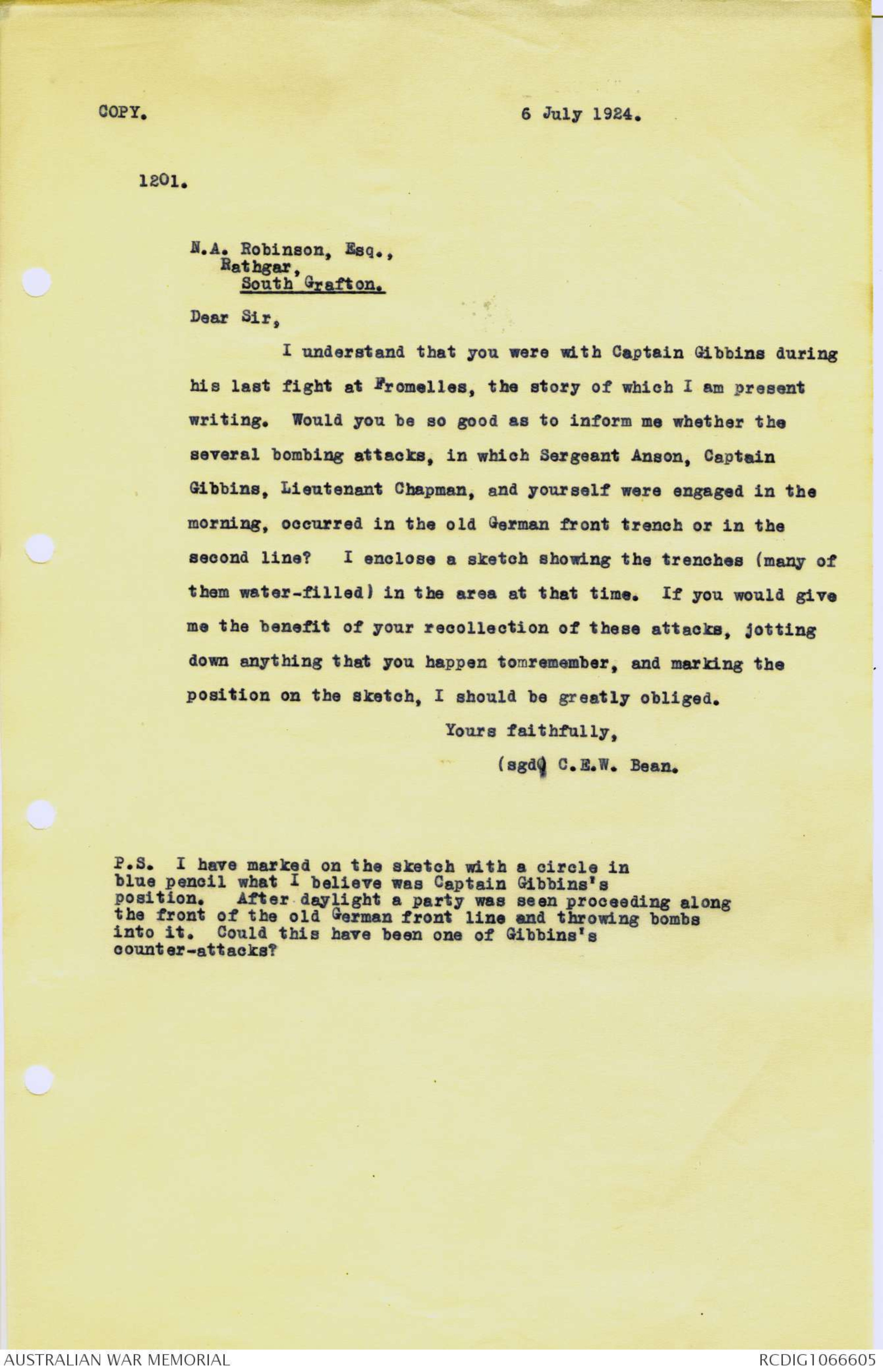
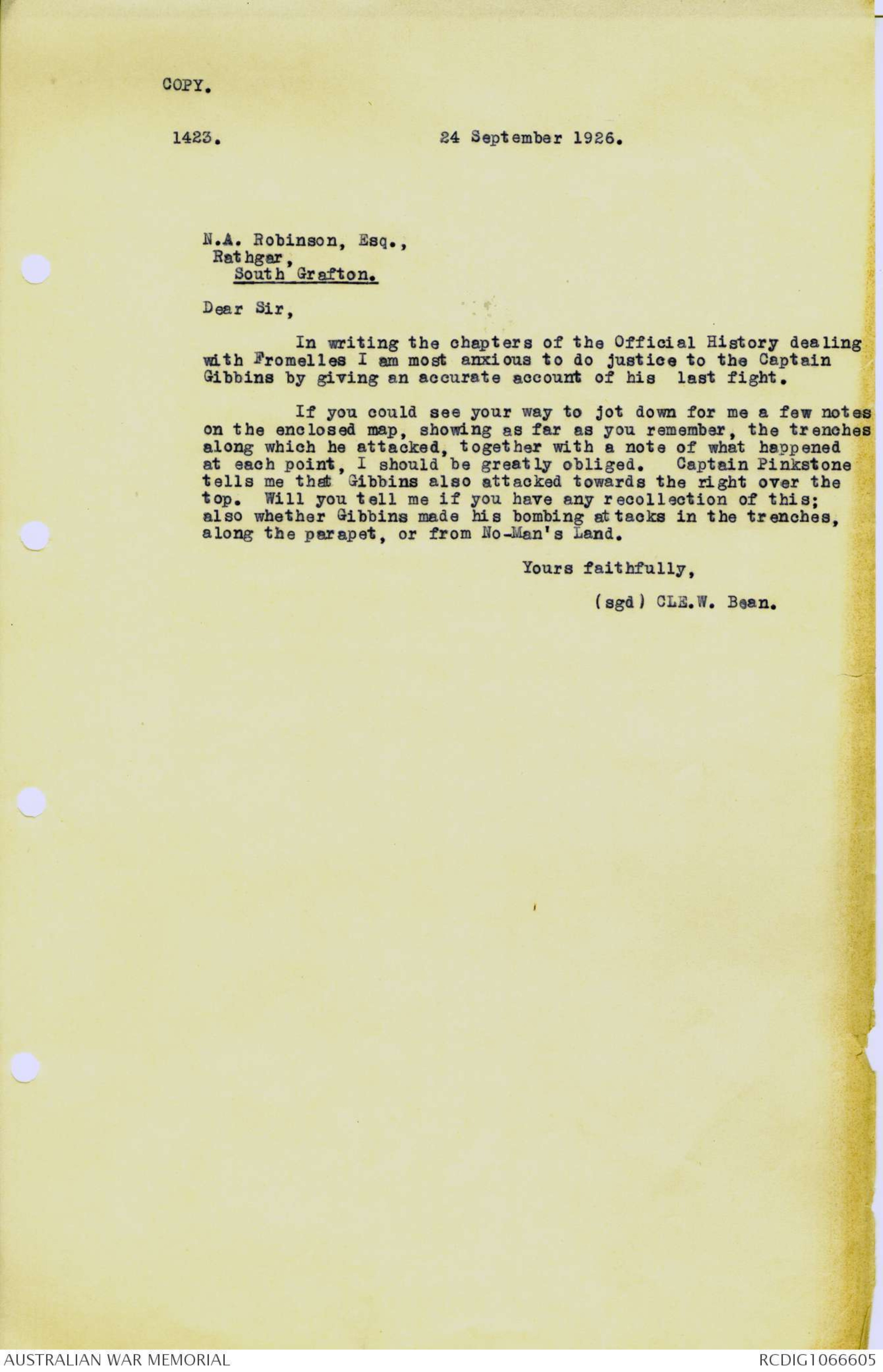
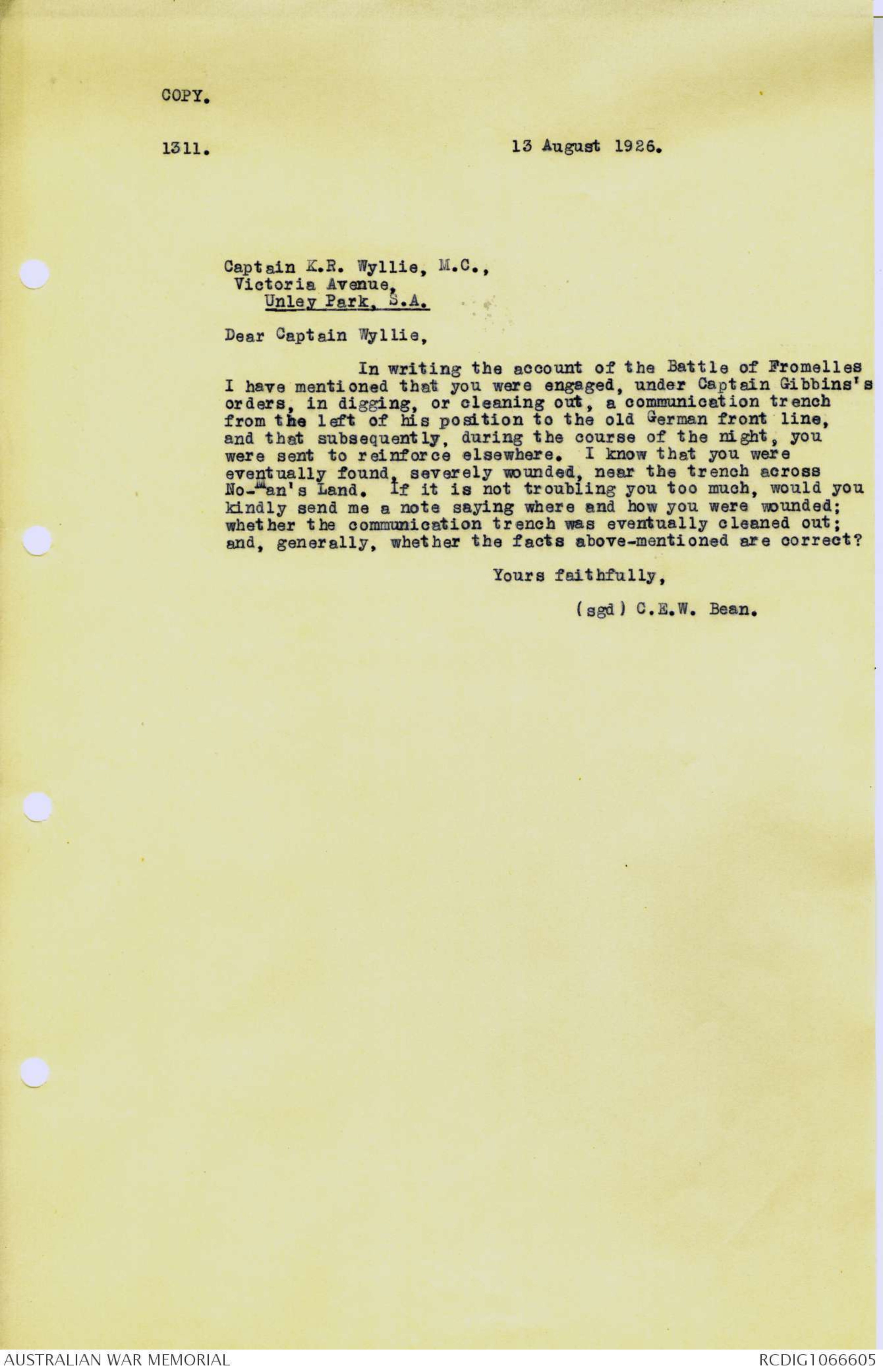
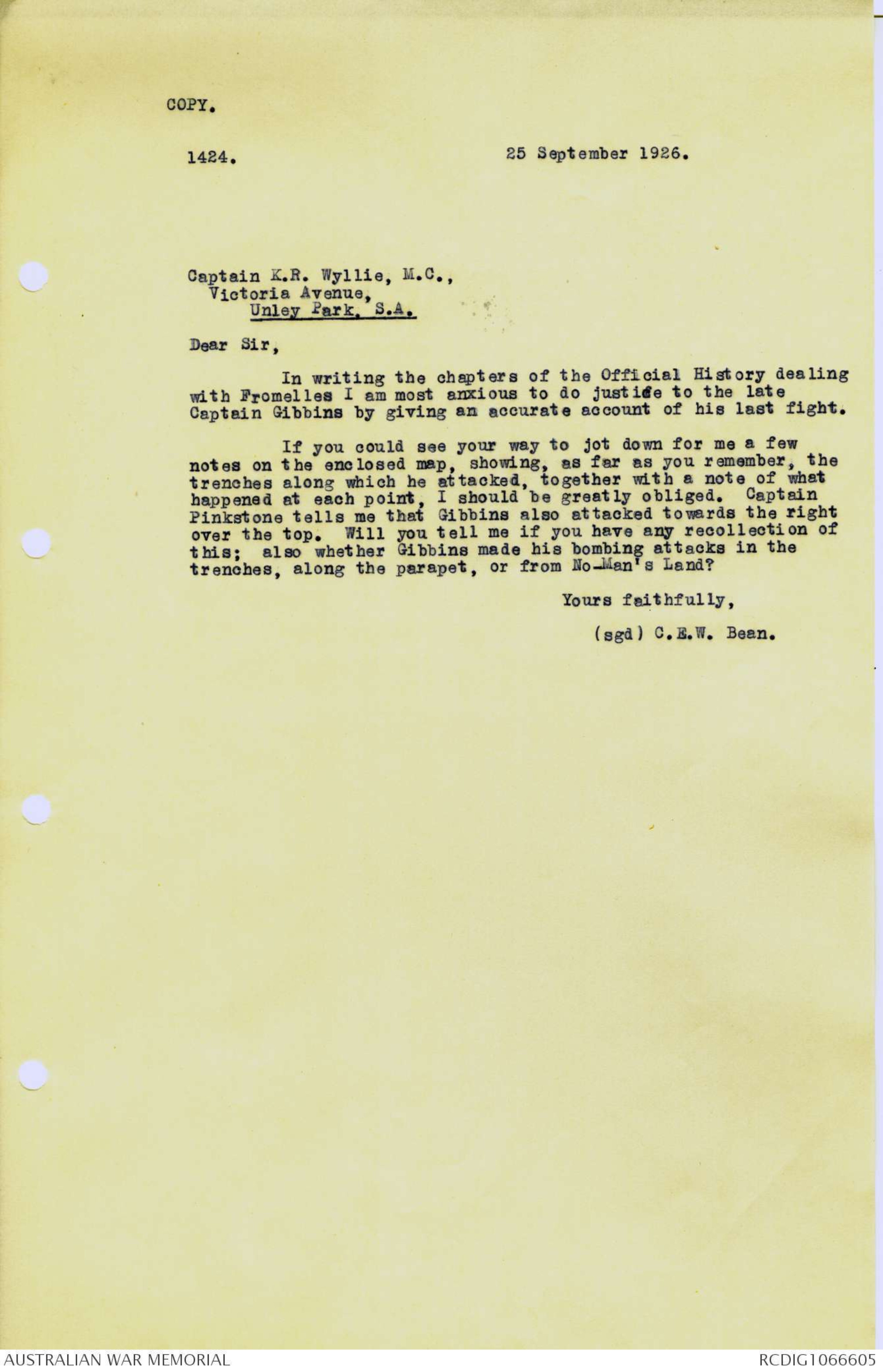
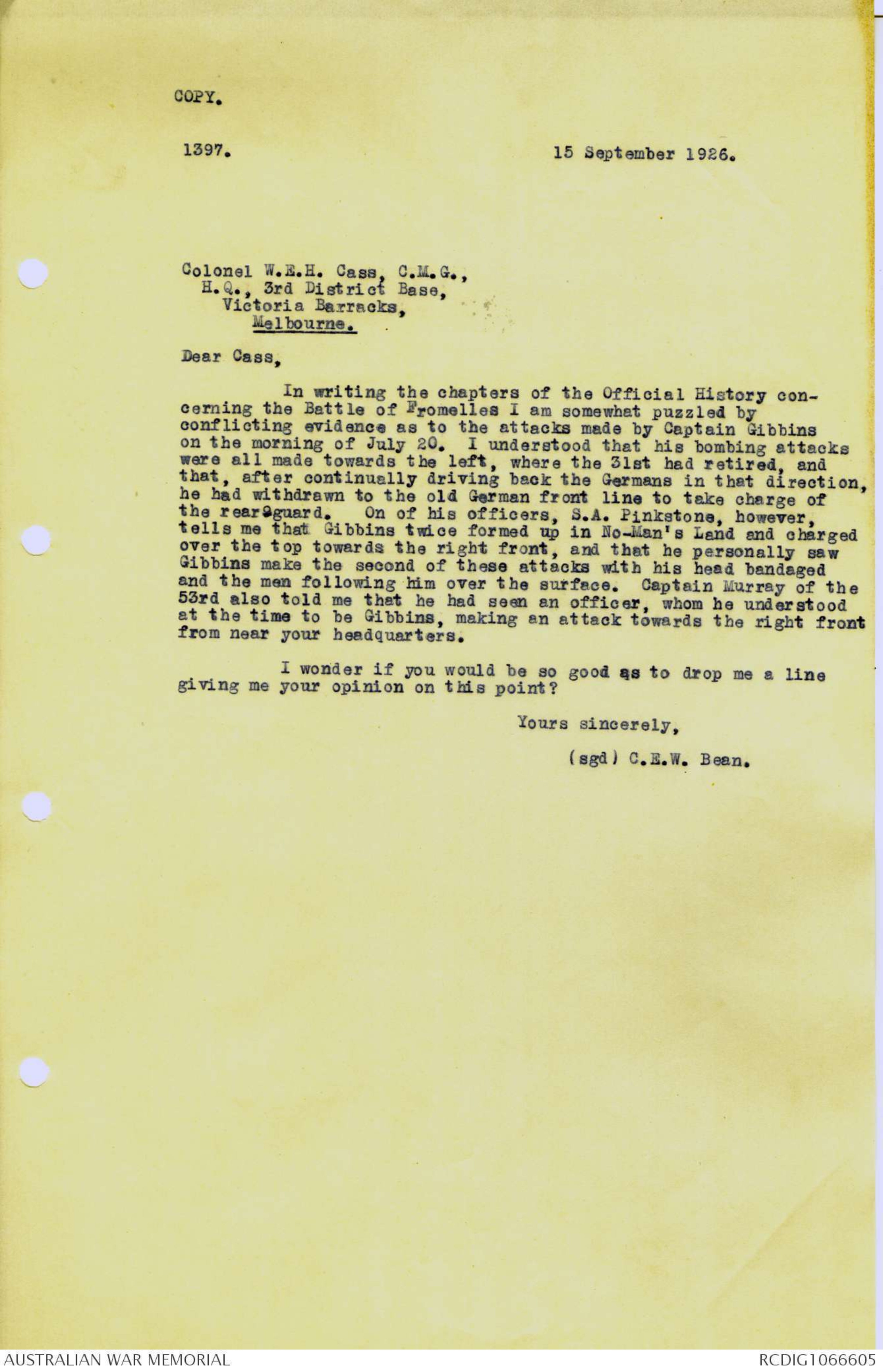

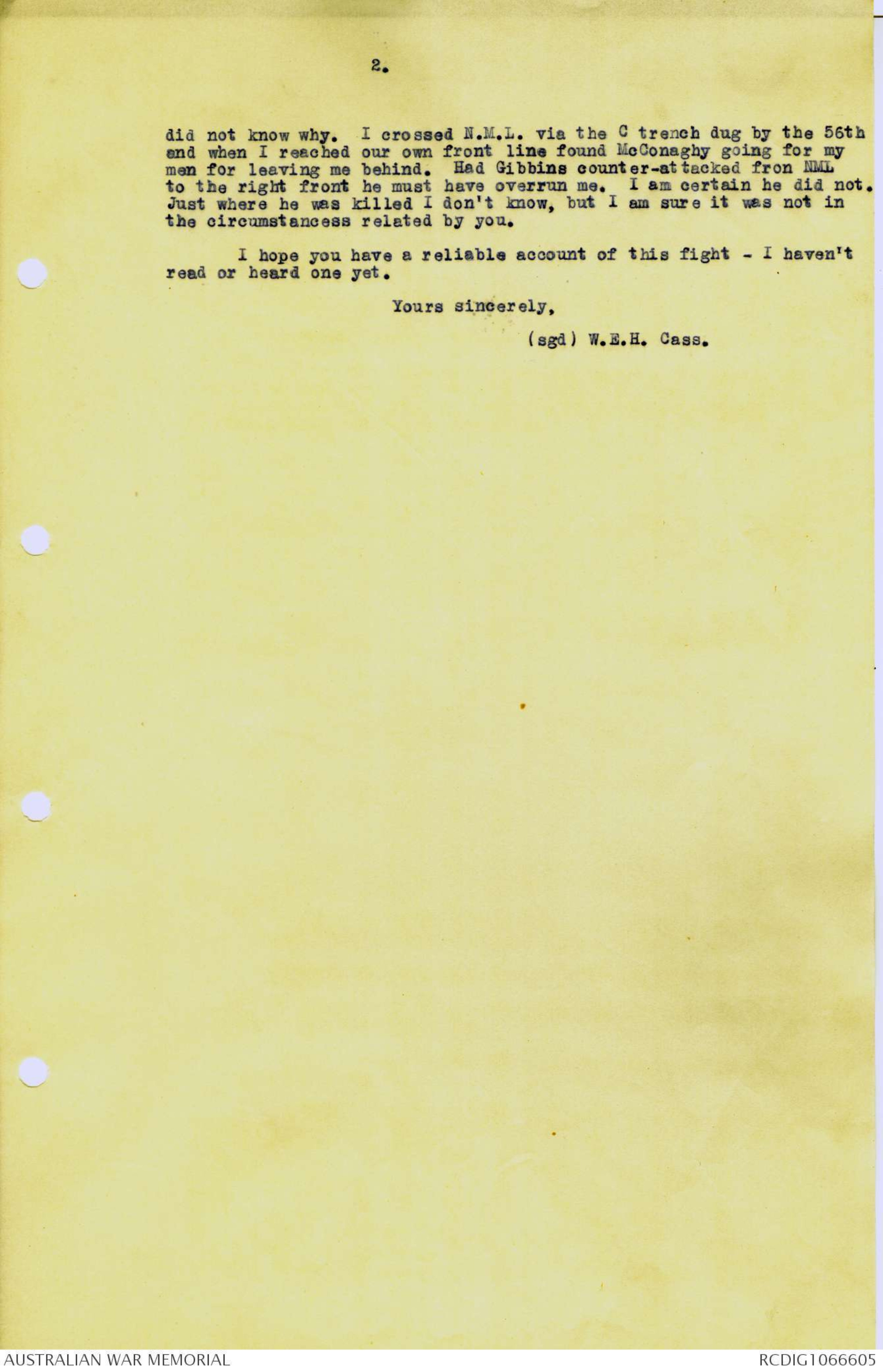
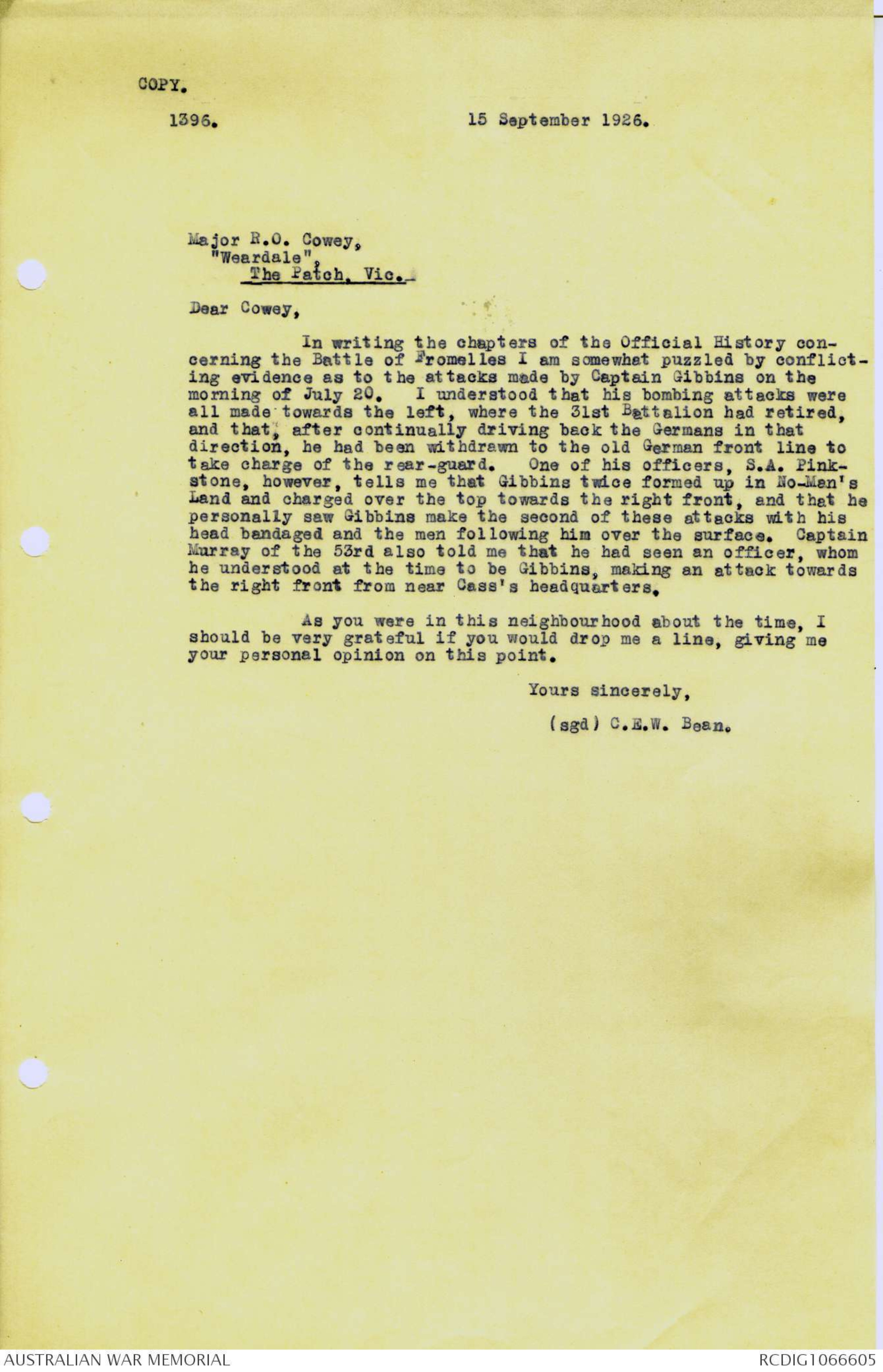
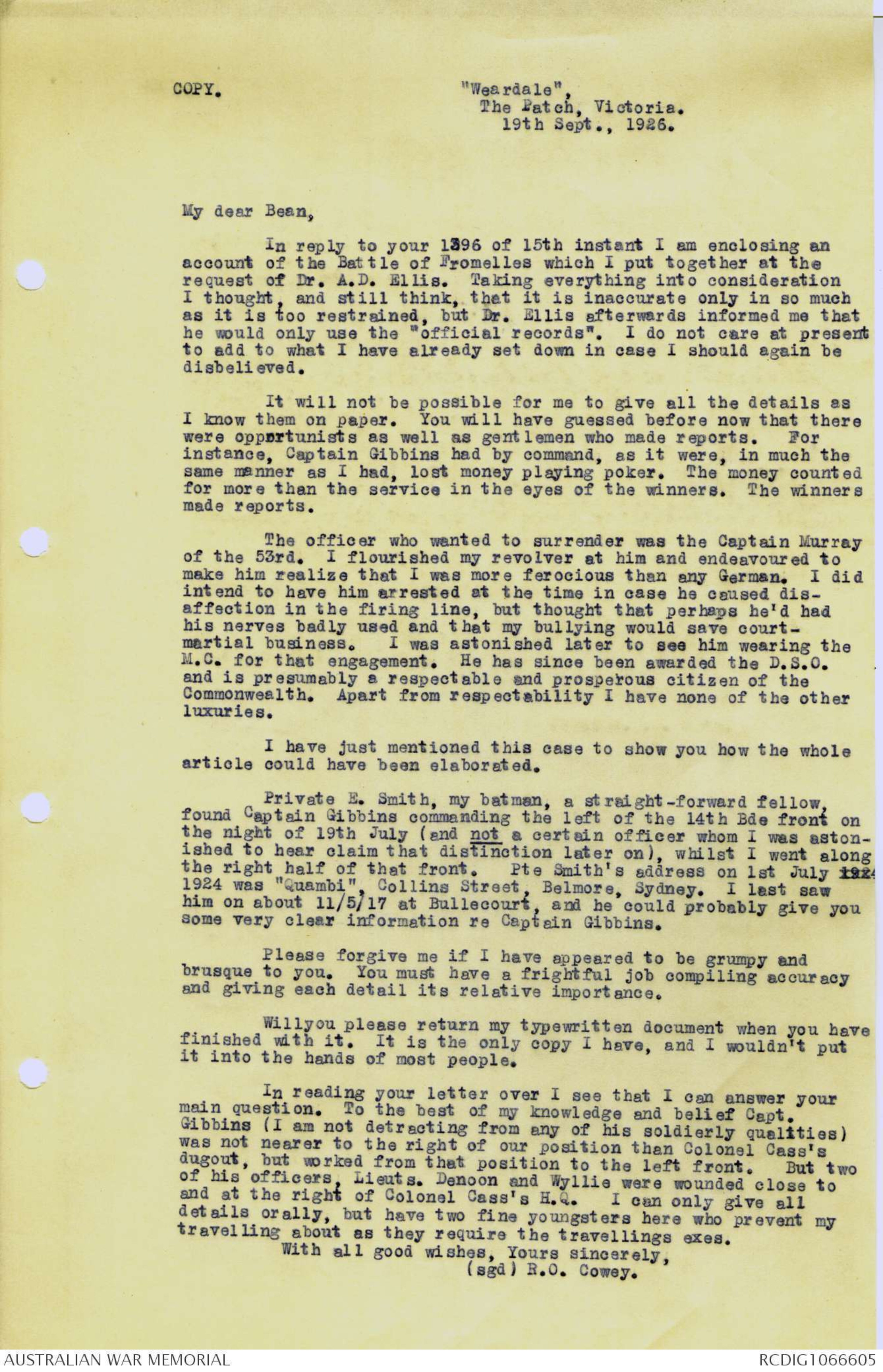
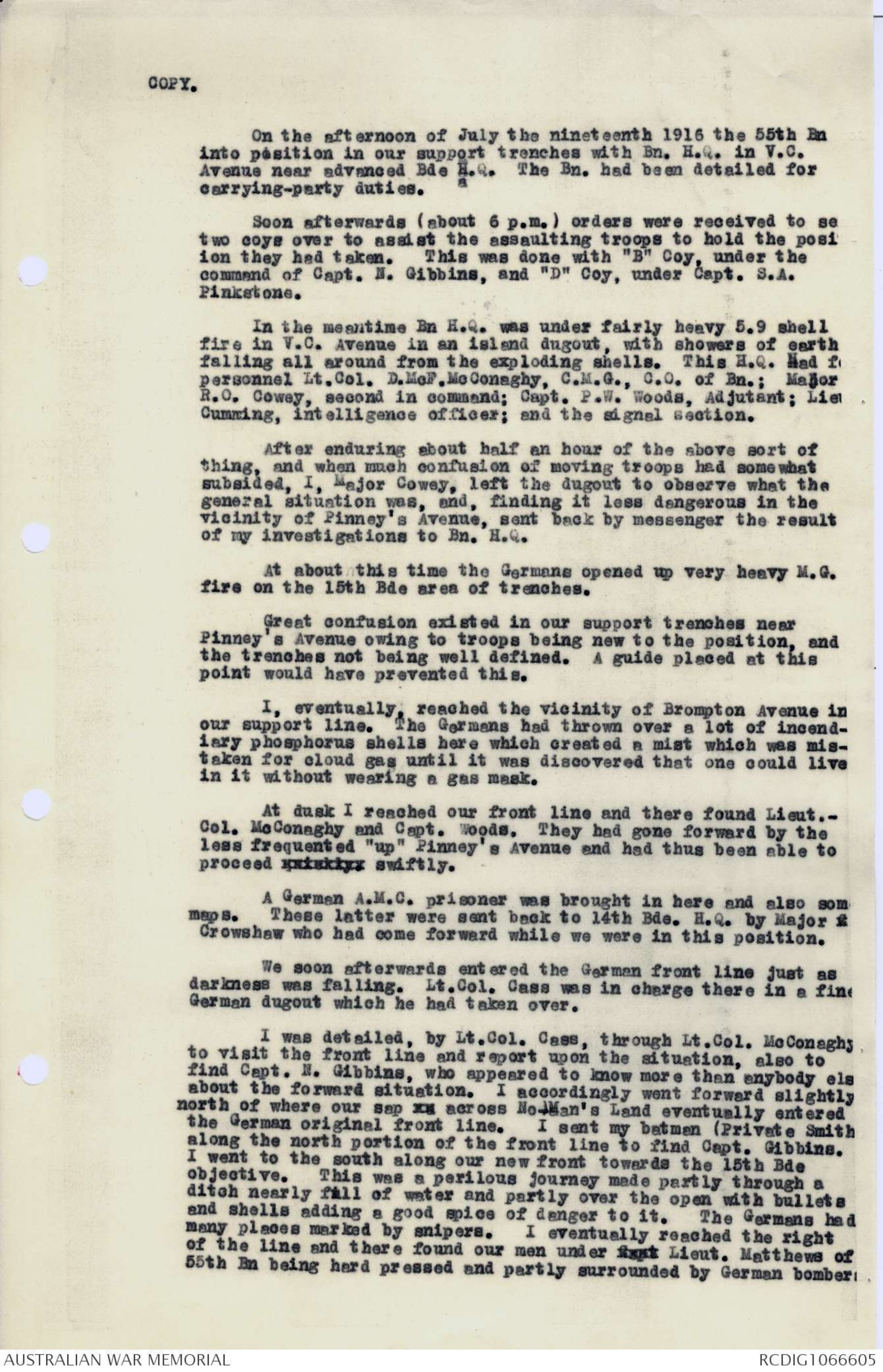
COPY.
6 July 1924.
1201.
N.A. Robinson, Esq.,
Rathgar
South Grafton,
Dear Sir,
I understand that you were with Captain Gibbins during
his last fight at Fromelles, the story of which I am present
writing. Would you be so good as to inform me whether the
several bombing attacks, in which Sergeant Anson, Captain
Gibbins, Lieutenant Chapman, and yourself were engaged in the
morning, occurred in the old German front trench or in the
second line? I enclose a sketch showing the trenches (many of
them water-filled) in the area at that time. If you would give
me the benefit of your recollection of these attacks, jotting
down anything that you happen tomremember, and marking the
position on the sketch, I should be greatly obliged.
Yours faithfully,
(sgd) C.E.W. Bean.
P.S. I have marked on the sketch with a circle in
blue pencil what I believe was Captain Gibbins's
position. After daylight a party was seen proceeding along
the front of the old German front line and throwing bombs
into it. Could this have been one of Gibbins's
counter-attacks?
COPY.
1423.
24 September 1926.
N.A. Robinson, Esq.,
Rathgar
South Grafton.
Dear Sir,
In writing the chapters of the Official History dealing
with Fromelles I am most anxious to do justice to the Captain
Gibbins by giving an accurate account of his last fight.
If you could see your way to jot down for me a few notes
on the enclosed map, showing as far as you remember, the trenches
along which he attacked, together with a note of what happened
at each point, I should be greatly obliged. Captain Pinkstone
tells me that Gibbins also attacked towards the right over the
top. Will you tell me if you have any recollection of this;
also whether Gibbins made his bombing attacks in the trenches,
along the parapet, or from No-Man's Land.
Yours faithfully,
(sgd) CLE.W. Bean.
COPY.
1311.
13 August 1926.
Captain K.R. Wyllie, M.C.,
Victoria Avenue
Unley Park, S.A.
Dear Captain Wyllie
In writing the account of the Battle of Fromelles
I have mentioned that you were engaged, under Captain Gibbins's
orders, in digging, or cleaning out, a communication trench
from the left of his position to the old German front line
and that subsequently, during the course of the night, you
were sent to reinforce elsewhere. I know that you were
eventually found, severely wounded, near the trench across
No-Man's Land. If it is not troubling you too much, would you
kindly send me a note saying where and how you were wounded;
whether the communication trench was eventually cleaned out;
and, generally, whether the facts above-mentioned are correct?
Yours faithfully,
(sgd) C.E.W. Bean.
COPY.
25 September 1926.
1424.
Captain K.R. Wyllie, M.C.,
Victoria Avenue
Unley Park, S.A.
Dear Sir,
In writing the chapters of the Official History dealing
with Fromelles I am most anxious to do justice to the late
Captain Gibbins by giving an accurate account of his last fight.
If you could see your way to jot down for me a few
notes on the enclosed map, showing, as far as you remember, the
trenches along which he attacked, together with a note of what
happened at each point, I should be greatly obliged. Captain
Pinkstone tells me that Gibbins also attacked towards the right
over the top. Will you tell me if you have any recollection of
this; also whether Gibbins made his bombing attacks in the
trenches, along the parapet, or from No-Man's Land?
Yours faithfully,
(sgd) C.E.W. Bean.
COPY.
1397.
15 September 1926.
Colonel W.E.H. Cass, C.M.G.,
H.Q., 3rd District Base,
Victoria Barracks,
Melbourne
Dear Cass,
In writing the chapters of the Official History concerning
the Battle of Fromelles I am somewhat puzzled by
conflicting evidence as to the attacks made by Captain Gibbins
on the morning of July 20. I understood that his bombing attacks
were all made towards the left, where the 31st had retired, and
that, after continually driving back the Germans in that direction,
he had withdrawn to the old German front line to take charge of
the rear9guard. On of his officers, S.A. Pinkstone, however
tells me that Gibbins twice formed up in No-Man's Land and charged
over the top towards the right front, and that he personally saw
Gibbins make the second of these attacks with his head bandaged
and the men following him over the surface. Captain Murray of the
53rd also told me that he had seen an officer, whom he understood
at the time to be Gibbins, making an attack towards the right front
from near your headquarters.
I wonder if you would be so good as to drop me a line
giving me your opinion on this point?
Yours sincerely,
(sgd) C.E.W. Bean.
COPY.
25th September.
My dear Bean,
Your letter of the 15th September has been unanswered
because I have been away from the office for about ten days on
the sick list. Please excuse the delay.
I am quite sure that your informants are making a mistake
and that there was no "forming up" in No-Man's Land or counter-attack
from No-Man's Land back on the German trenches. The
ground held was roughly as under
A being my right flank 54th and 53rd Bn formed when I
found that the 15th Bde had failed to get in.
B was a drain improved into a trench and held by 54 Bn.
C was my left flank formed of one coy 55th (Gibbins) when
the 8th Bde fell back.
D was the old German front line held by McConaghy with
one coy 55th.
When I told McC. that we should probably get the order
to withdraw I told him to form a rear-guard - that he had one
coy practically untouched and that it would cover the retirement.
Unknown to me he told Gibbins to command the rear-guard and withdrew
this company with him when he went. Gibbins brought his coy
from C to form the rear-guard and the Huns followed, thus getting
behind my men at B. These men from B went through and over the
Huns who had followed Gibbins, and somecontinued over D into No-Man's
Land and across to the British line - many being shot down
as they went. I saw many crossing No-Man's Land, but at the time
2.
did not know why. I crossed N.M.L. via the C trench dug by the 56th
and when I reached our own front line found McConaghy going for my
men for leaving me behind. Had Gibbins counter-attacked fron NML
to the right front he must have overrun me. I am certain he did not.
Just where he was killed I don't know, but I am sure it was not in
the circumstancess related by you.
I hope you have a reliable account of this fight - I haven't
read or heard one yet.
Yours sincerely,
(sgd) W.E.H. Cass.
COPY.
1396. 15 September 1926.
Major R.O. Cowey,
"Weardale",
The Patch, Vic.
Dear Cowey,
In writing the chapters of the Official History concerning
the Battle of Fromelles I am somewhat puzzled by conflicting
evidence as to the attacks made by Captain Gibbins on the
morning of July 20. I understood that his bombing attacks were
all made towards the left, where the 31st Battalion had retired,
and that, after continually driving back the Germans in that
direction, he had been withdrawn to the old German front line to
take charge of the rear-guard. One of his officers, S.A. Pinkstone,
however, tells me that Gibbins twice formed up in No-Man's
Land and charged over the top towards the right front, and that he
personally saw Gibbins make the second of these attacks with his
head bandaged and the men following him over the surface. Captain
Murray of the 53rd also told me that he had seen an officer, whom
he understood at the time to be Gibbins, making an attack towards
the right front from near Cass's headquarters.
As you were in this neighborhood about the time, I
should be very grateful if you would drop me a line, giving me
your personal opinion on this point.
Yours sincerely,
(sgd) C.E.W. Bean.
COPY.
"Weardale"
Victoria.
The Patch,
19th Sept., 1926.
My dear Bean,
In reply to your 1396 of 15th instant I am enclosing an
account of the Battle of Fromelles which I put together at the
request of Dr. A.D. Ellis. Taking everything into consideration
I thought, and still think, that it is inaccurate only in so much
as it is too restrained, but Dr. Ellis afterwards informed me that
he would only use the "official records". I do not care at present
to add to what I have already set down in case I should again be
disbelieved.
It will not be possible for me to give all the details as
I know them on paper. You will have guessed before now that there
were oppportunists as well as gentlemen who made reports. For
instance, Captain Gibbins had by command, as it were, in much the
same manner as I had, lost money playing poker. The money counted
for more than the service in the eyes of the winners. The winners
made reports.
The officer who wanted to surrender was the Captain Murray
of the 53rd. I flourished my revolver at him and endeavoured to
make him realize that I was more ferocious than any German. I did
intend to have him arrested at the time in case he caused disaffection
in the firing line, but thought that perhaps he'd had
his nerves badly used and that my bullying would save court-martial
business. I was astonished later to see him wearing the
M.C. for that engagement. He has since been awarded the D.S.O.
and is presumably a respectable and prosperous citizen of the
Commonwealth. Apart from respectability I have none of the other
luxuries.
I have just mentioned this case to show you how the whole
article could have been elaborated.
Private E. Smith, my batman, a straight-forward fellow,
found Captain Gibbins commanding the left of the 14th Bde front on
the night of 19th July (and not a certain officer whom I was astonished
to hear claim that distinction later on), whilst I went along
the right half of that front. Pte Smith's address on 1st July 192
1924 was "Quambi" Collins Street, Belmore, Sydney. I last saw
him on about 11/5/17 at Bullecourt, and he could probably give you
some very clear information re Captain Gibbins.
Please forgive me if I have appeared to be grumpy and
brusque to you. You must have a frightful job compiling accuracy
and giving each detail its relative importance.
Willyou please return my typewritten document when you have
finished with it. It is the only copy I have, and I wouldn't put
it into the hands of most people.
In reading your letter over I see that I can answer your
main question. To the best of my knowledge and belief Capt.
Gibbins (I am not detracting from any of his soldierly qualities)
was not nearer to the right of our position than Colonel Cass's
dugout, but worked from that position to the left front. But two
of his officers, Lieuts. Denoon and Wyllie were wounded close to
and at the right of Colonel Cass's H.Q. I can only give all
details orally, but have two fine youngsters here who prevent my
travelling about as they require the travellings exes.
With all good wishes, Yours sincerely,
(sgd) R.O. Cowey.
COPY.
On the afternoon of July the nineteenth 1916 the 55th Bn
into position in our support trenches with Bn. H.Q. in V.C.
Avenue near advanced Bde H.Q. The Bn. had been detailed for
carrying-party duties.
Soon afterwards (about 6 p.m.) orders were received to se
two coys over to assist the assaulting troops to hold the position
they had taken. This was done with "B" Coy, under the
command of Capt. N. Gibbins, and "D" Coy, under Capt. S.A.
Pinkstone.
In the meantime Bn H.Q. was under fairly heavy 5.9 shell
fire in V.C. Avenue in an island dugout, with showers of earth
falling all around from the exploding shells. This H.Q. had for
personnel Lt.Col. D.McF. McConaghy, C.M.G., C.O. of Bn.; Major
R.O. Cowey, second in command; Capt. P.W. Woods, Adjutant; Lieut
Cumming, intelligence officer; and the signal section.
After enduring about half an hour of the above sort of
thing, and when much confusion of moving troops had somewhat
subsided, I, Major Cowey, left the dugout to observe what the
general situation was, and, finding it less dangerous in the
vicinity of Pinney's Avenue, sent back by messenger the result
of my investigations to Bn. H.Q.
At about this time the Germans opened up very heavy M.G.
fire on the 15th Bde area of trenches.
Great confusion existed in our support trenches near
Pinney's Avenue owing to troops being new to the position, and
the trenches not being well defined. A guide placed at this
point would have prevented this.
I, eventually, reached the vicinity of Brompton Avenue in
our support line. The Germans had thrown over a lot of incendiary
phosphorus shells here which created a mist which was mistaken
for cloud gas until it was discovered that one could live
in it without wearing a gas mask.
At dusk I reached our front line and there found Lieut.-Col.
McConaghy and Capt. Woods. They had gone forward by the
less frequented "up" Pinney's Avenue and had thus been able to
proceed xxxxxxxx swiftly.
A German A.M.C. prisoner was brought in here and also some
maps. These latter were sent back to 14th Bde. H.Q. by Major x
Crowshaw who had come forward while we were in this position.
We soon afterwards entered the German front line just as
darkness was falling. Lt. Col. Cass was in charge there in a fine
German dugout which he had taken over.
I was detailed, by Lt.Col. Cass, through Lt.Col. McConaghy
to visit the front line and report upon the situation, also to
find Capt. N. Gibbins, who appeared to know more than anybody else
about the forward situation. I accordingly went forward slightly
north of where our sap xx across No-Man's Land eventually entered
the German original front line. I sent my batmen (Private Smith
along the north portion of the front line to find Capt. Gibbins.
I went to the south along our new front towards the 15th Bde
objective. This was a perilous journey made partly through a
ditch nearly full of water and partly over the open with bullets
and shells adding a good spice of danger to it. The Germans had
many places marked by snipers. I eventually reached the right
of the line and there found our men under Capt Lieut. Matthews of
55th Bn being hard pressed and partly surrounded by German bombers
 Lulu B
Lulu BThis transcription item is now locked to you for editing. To release the lock either Save your changes or Cancel.
This lock will be automatically released after 60 minutes of inactivity.